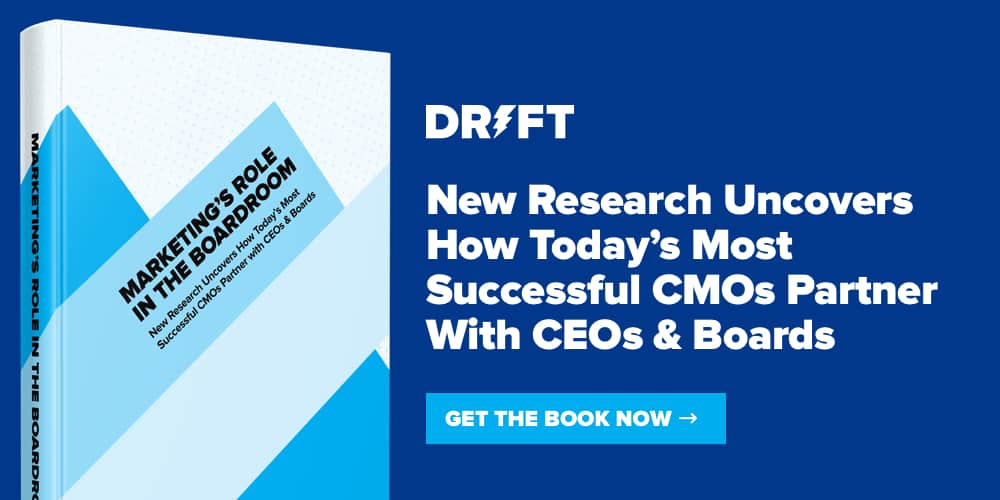
As marketers, it’s easy for us to see the value in what we do. But what about for the sales team? What about for the CEO and Board? How often have you run into the challenge of having to justify marketing’s direction?
How often have you been in the hot seat?
For marketing to be seen as a reliable revenue-driver today, the onus is on CMOs to not only create programs that support the goals of the business, but to also communicate the efficacy of those programs to sales leaders, their CEO, and their Board.
While it’s hard enough for CMOs and their marketing teams to successfully navigate the increasingly complex landscape of sellers, buyers, and competitors, it’s another challenge altogether for these marketing leaders to effectively communicate marketing’s success across the organization. And as new data and insights become more widely available, as strategies grow more complex, and as tactics continue to encompass more channels and more personalization, this need will only continue to grow.
But striking that cross-functional alignment of marketing’s strategies and goals not only with those of the sales team, but also of the larger organization, is a balancing act that requires much more than luck.
So how do today’s best-in-class CMOs bridge the gaps? How do today’s most successful marketing leaders find alignment with their CEOs and Boards? What challenges have they learned to overcome? What opportunities have they taken advantage of to find success?
Drift, G2, and Heinz Marketing conducted new research to identify the trends, gaps, and opportunities to better understand how today’s CMOs achieve alignment and communicate marketing’s success to their sales teams, CEOs and Boards.
You can access all of our findings in our new report here, or keep scrolling for a preview ?
Following Three Core Tenets To Achieve Alignment
Our research revealed three core tenets – or focus areas – that enable alignment, drive productivity, and facilitate stronger relationships between marketing, sales, and the leadership team. For CMOs (or any marketing leader) to effectively align and communicate marketing’s success to the greater organization, these three tenets must be strengthened first:
- Clear Communication, to gain stakeholder buy-in and trust.
- Meaningful Data, to measure, track, and report on what’s needed most to move the needle.
- Justified Priorities, to validate your decisions and instill confidence in your approach.
Tenet 1: Communication
To gain stakeholder buy-in, CMOs must be able to clearly, efficiently, and effectively communicate to their leadership team not only what they’re doing, but also the role their actions play in the larger scope and strategy of the business.
Communication is crucial to ensure that every participant – from Board member to CEO to director to manager – understands what their role is in the greater sales and marketing program, and how they fit into the larger strategy of the organization.
To that end, there are 3 primary stakeholders who CMOs must learn to communicate and align with:
- The Executive Board
- The CEO
- Sales Leadership
However, each stakeholder cohort comes with their own set of communication challenges that CMOs must learn to address if they want to improve not only how they communicate with these groups, but also what they communicate.
Utilizing the resources and tools at their disposal, CMOs and marketing leaders must work to understand exactly what each cohort needs to see. Where sales leaders will want to know your plan to generate qualified leads and encourage account engagement, the CEO and Board will be more focused on how your campaigns ultimately influence and generate revenue. And while CMOs can talk at-length about their plans and budgets and conversion rates, the meaningful data – the real revenue-impacting data – is still an area where CMOs, and many marketers in general, are working to improve.
Tenet 2: Data
Marketers are no longer just responsible for what happens at the top of the funnel. In order to truly move the needle, CMOs need to know what metrics they should measure, how they plan on tracking those metrics, and what’s needed most to move the needle on company goals.
The data challenge
To align with sales leaders, the CEO, and Board, CMOs have work to do when it comes to data and analytics. The unfortunate reality is that many data systems and reporting capabilities live in silos – unable to clearly communicate between sales and marketing. This leads to fragmented reporting and a lack of a full-picture view, and ultimately, hinders the prospect experience in the process. And, in an age where marketing is expected to deliver more, these are shortcomings that can’t be overlooked.
Marketing, for so long, has been focused on delivering leads and MQLs. And the current swath of marketing automation platforms hasn’t done much to help marketers gain a better picture of the leads they hand-off (or, in some cases, throw blindly) to sales.
While marketing can see what content leads have downloaded, how long they’ve been on a webpage, and whether or not they’ve clicked on an email, those actions don’t do much to reveal a lead’s intent to buy – let alone the intent of an entire account.
Pipeline velocity is a missed opportunity
According to CMOs, the three most important metrics to track are:
- Marketing-influenced revenue
- Lead-to-close conversion rates
- Pipeline generation
The least important metric to track, according to CMOs? Pipeline velocity – arguably one of the most important metrics to a business overall. In today’s increasingly complex sales and marketing landscape, pipeline velocity is a metric that every sales and marketing leader needs to consider. Because when pipeline velocity slows, it doesn’t only mean that sales isn’t closing deals. It also brings into view a much larger issue: that marketing isn’t delivering enough qualified leads for sales to close.
CMOs need to keep a closer eye on the speed and health of their pipeline. However, today’s marketing automation platforms and CRM solutions may not make viewing this metric as easy as one would hope. From the amount of customization, to detailed level of configuration, to the ongoing management of the dataset to ensure that it’s always up-to-date, tracking pipeline velocity at-scale may be just out of reach.
The data challenge in marketing extends well-beyond the technology at one’s disposal – it’s a much larger discussion about the entire sales, marketing, and business relationship. While marketing may qualify a lead as ready for sales, sales may have another view entirely. And without this alignment of priorities and measures of success, sales and marketing will only continue to grow further apart.
Tenet 3: Justified Priorities
Justification should come from a variety of sources
To justify their priorities, CMOs utilize a variety of sources, data points, and references whether it be proprietary data, competitor data, and/or third-party research.
Utilizing the learnings of the previous tenets to gain stakeholder buy-in, streamline communication, agree on and define the metrics of success, and further align with sales, CMOs can more easily justify their priorities, validate their decisions, and instill confidence in their executive team.
Final Takeaway
Communicating marketing’s results, value, and ROI to company leadership is by no means an easy conversation, but it’s one that’s entirely necessary to have. These days, it’s not enough for marketing leaders to simply demonstrate value on their own; they are just a piece of the revenue puzzle. And as marketing and sales teams work together more closely in the years to come, they will only continue to share both the burden and success of revenue results.







